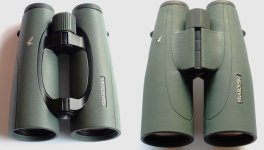Worrying about credentialed experts and the proper terminology reminds me too much being at work! I'm a layperson here in hobby-land. That's why I avoid words like "resolution"....the views are more "alive" with bigger aperture works for me. I don't have to deal with the physics!  Above my pay grade.
Above my pay grade.
btw I came across another good post on the 10x56SLC/10x50EL decision, this echoes many of my own thoughts about them, and the HT's - maybe Joachim posted it on BF somewhere too, here is a translated version:
Swarovski SLC 10x56 or EL 10x50 or Zeiss HT 10x54?
btw I came across another good post on the 10x56SLC/10x50EL decision, this echoes many of my own thoughts about them, and the HT's - maybe Joachim posted it on BF somewhere too, here is a translated version:
Swarovski SLC 10x56 or EL 10x50 or Zeiss HT 10x54?
Swarovski SLC 10x56 oder EL 10x50 oder Zeiss HT 10x54
Swarovski SLC 10x56 oder EL 10x50 oder Zeiss HT 10x54? Vor ein paar Wochen hatte ich wieder meinen Händler in Braunschweig aufgesucht, um mir ein paar Gläser anzusehen. Da das SLC 10x56 direkt vor mir stand, hab ich es mit nach draussen genommen. Beim Durchsehen kam der für mich völlig überraschend
www-osj--forum-de.translate.goog










